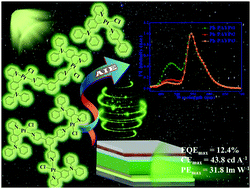Mono-, di- and tri-nuclear PtII(C^N)(N-donor ligand)Cl complexes showing aggregation-induced phosphorescent emission (AIPE) behavior for efficient solution-processed organic light-emitting devices†
Abstract
Mono-, di- and tri-nuclear PtII(C^N)(N-donor ligand)Cl complexes Ph-PAYPt1, Ph-PAYPt2 and Ph-PAYPt3 are designed and prepared. Their thermal stability, photophysical properties and electroluminescence abilities in solution-processed organic light-emitting devices (OLEDs) have been fully characterized. In dilute solution, all the Pt(II) complexes exhibit much a lower phosphorescent quantum yield (ΦP) compared with the data obtained in the doped polymethyl methacrylate (PMMA) film at the doping level of 6 wt%. By adding water to the THF solutions of these mono-, di- and tri-nuclear Pt(II) complexes, the phosphorescent emission can be enhanced clearly, indicating aggregation-induced phosphorescent emission (AIPE) behavior. Electroluminescence (EL) characterizations indicate that their EL ability falls in the order of Ph-PAYPt2 > Ph-PAYPt1 > Ph-PAYPt3. The dinuclear complex Ph-PAYPt2 can achieve the highest EL efficiency among these complexes in solution-processed OLEDs with the external quantum efficiency (ηext) of 12.4%, a current efficiency (ηL) of 43.8 cd A−1 and a power efficiency (ηp) of 31.8 lm W−1. Furthermore, using this solution method, three-primary color white-light OLEDs (WOLEDs) that were prepared based on Ph-PAYPt2 also show good EL performance and stable white EL spectra. The optimized WOLED shows a maximum ηext of 12.5%, an ηL of 42.3 cd A−1 and an ηp of 31.8 lm W−1. All these results indicate the great potential of these mono-, di- and tri-nuclear PtII(C^N)(N-donor ligand)Cl complexes with AIPE properties in the field of OLEDs.

- This article is part of the themed collection: Materials Chemistry in Xi’an Jiaotong University


 Please wait while we load your content...
Please wait while we load your content...